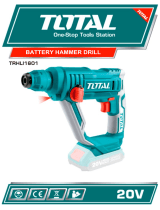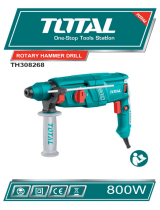The DeWalt D25414K Heavy-Duty Rotary Hammer is a versatile tool capable of drilling into various materials, including metal, wood, and concrete. It features a powerful 1000-watt motor that delivers up to 4.2 joules of impact energy for demanding applications. The rotary hammer also has a variable speed trigger for precise control and a reverse function for easy bit removal. It comes with a side handle for improved grip and control, and a depth rod for accurate drilling. Additionally, the D25414K includes a carrying case for easy storage and transportation.
The DeWalt D25414K Heavy-Duty Rotary Hammer is a versatile tool capable of drilling into various materials, including metal, wood, and concrete. It features a powerful 1000-watt motor that delivers up to 4.2 joules of impact energy for demanding applications. The rotary hammer also has a variable speed trigger for precise control and a reverse function for easy bit removal. It comes with a side handle for improved grip and control, and a depth rod for accurate drilling. Additionally, the D25414K includes a carrying case for easy storage and transportation.
















-
 1
1
-
 2
2
-
 3
3
-
 4
4
-
 5
5
-
 6
6
-
 7
7
-
 8
8
-
 9
9
-
 10
10
-
 11
11
-
 12
12
-
 13
13
-
 14
14
-
 15
15
-
 16
16
DeWalt D25414K User manual
- Category
- Power tools
- Type
- User manual
The DeWalt D25414K Heavy-Duty Rotary Hammer is a versatile tool capable of drilling into various materials, including metal, wood, and concrete. It features a powerful 1000-watt motor that delivers up to 4.2 joules of impact energy for demanding applications. The rotary hammer also has a variable speed trigger for precise control and a reverse function for easy bit removal. It comes with a side handle for improved grip and control, and a depth rod for accurate drilling. Additionally, the D25414K includes a carrying case for easy storage and transportation.
Ask a question and I''ll find the answer in the document
Finding information in a document is now easier with AI
Related papers
Other documents
-
Ryobi ERH710RG Owner's Operating Manual
-
 Total TRHLI1601 20V Battery Hammer Drill Owner's manual
Total TRHLI1601 20V Battery Hammer Drill Owner's manual
-
Worx WX333 Safety And Operating Manual
-
Ryobi SDS65 User manual
-
Ryobi P223 Owner's manual
-
Total TH215002 Demolition Hammer Owner's manual
-
RIDGID R86710B User manual
-
MasterForce 241-0465 User manual
-
 Total TH308268 Owner's manual
Total TH308268 Owner's manual
-
Ryobi P1968N User guide

















